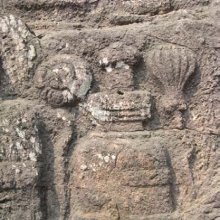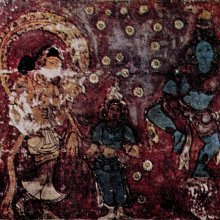Lily: 2 definitions
Introduction:
Lily means something in Hinduism, Sanskrit, biology. If you want to know the exact meaning, history, etymology or English translation of this term then check out the descriptions on this page. Add your comment or reference to a book if you want to contribute to this summary article.
Images (photo gallery)
In Hinduism
Ayurveda (science of life)
Agriculture (Krishi) and Vrikshayurveda (study of Plant life)
Source: Asian Agri-History: Drumavichitrikaranam—The Ancient Approach to Plant MutagenesisLilies (Nymphaea sp.) were used in the process of organic plant mutagenesis by ancient Indian agriculturists, which presents a safe technology and methodology regarding organic agriculture, according to treatises (such as the Vrikshayurveda). One such technology was to produce flowers and fruits on other species of plants and trees: The term drumavichitrikaranam (“plant mutagenesis”) obtains its true meaning in the literal sense through this objective. Some of them are described in the Upavanavinoda of Śārṅgadhara: such as to grow Nymphaea sp. (lilies) from seeds of Cordia dichotoma (Indian cherry)—this is a transformation of a terrestrial tree into an aquatic herb. Also: to grow Hemionitis cordifolia (heart fern) from fruit of Nymphaea sp. (lily).—this is a transformation of an aquatic herb into a terrestrial fern. Also: to grow Nerium indicum (Indian oleander) from Nymphaeae sp. (lily)—an aquatic herb would bear flowers of a terrestrial shrub.

Āyurveda (आयुर्वेद, ayurveda) is a branch of Indian science dealing with medicine, herbalism, taxology, anatomy, surgery, alchemy and related topics. Traditional practice of Āyurveda in ancient India dates back to at least the first millenium BC. Literature is commonly written in Sanskrit using various poetic metres.
Biology (plants and animals)
Source: Google Books: CRC World Dictionary (Regional names)Lily in English is the name of a plant defined with Anemone coronaria in various botanical sources. This page contains potential references in Ayurveda, modern medicine, and other folk traditions or local practices.
Example references for further research on medicinal uses or toxicity (see latin names for full list):
· Fl. Libya (1984)
· Species Plantarum (1753)
· Taxon (1992)
If you are looking for specific details regarding Lily, for example chemical composition, extract dosage, health benefits, diet and recipes, side effects, pregnancy safety, have a look at these references.

This sections includes definitions from the five kingdoms of living things: Animals, Plants, Fungi, Protists and Monera. It will include both the official binomial nomenclature (scientific names usually in Latin) as well as regional spellings and variants.
See also (Relevant definitions)
Starts with: Lily gras, Lily of the desert, Lily of the field, Lily of the incas, Lily of the nile, Lily palm, Lily turf, Lily-of-the-valley, Lilyanyoka, Lilybind.
Ends with (+154): Africa lily, African arrow lily, African blood lily, African blue lily, African lily, Amazon lily, American troutlily, American water-lily, Arum lily, Atamasco lily, Autumn zephyr lily, Avalanche-lily, Barbados lily, Belladonna lily, Blackberry lily, Blood lily, Blue african lily, Blue bead-lily, Blue camas lily, Blue lily.
Full-text (+736): Kumuda, Saluka, Kuvalaya, Kuvalayita, Saugandhika, Kuvalayini, Kumudakara, Kairava, Kahlara, Utpala, Kumudini, Nalina, Kuvela, Water lily, Kallahara, Dhavalotpala, Kumudika, Vahnivarna, Shiphakanda, Somabandhu.
Relevant text
Search found 123 books and stories containing Lily; (plurals include: Lilies). You can also click to the full overview containing English textual excerpts. Below are direct links for the most relevant articles:
Taittiriya Upanishad Bhashya Vartika (by R. Balasubramanian)
Verse 2.52 < [Book 2 - Brahmavallī]
Verse 2.48 < [Book 2 - Brahmavallī]
Verse 2.49 < [Book 2 - Brahmavallī]
Amarakoshodghatana of Kshirasvamin (study) (by A. Yamuna Devi)
Flora (15): Hydrophytes and Phylum algae < [Chapter 5 - Aspects of Nature]
Kṣīrasvāmin’s citations of Bhoja < [Chapter 6 - Grammatical Aspects]
Words with special connotations < [Chapter 6 - Grammatical Aspects]
Satirical works of Kshemendra (study) (by Arpana Devi)
2. Kavisamaya or the poetic convention < [Chapter 4 - Literary study of the Three Satirical Works]
3. Summary of the Narmamālā < [Chapter 3 - Satirical Works of Kṣemendra]
Sanskrit sources of Kerala history (by Suma Parappattoli)
7.1. Nakshatramala < [Chapter 2 - Historical details from Mahatmyas and Prashastis]
The Markandeya Purana (by Frederick Eden Pargiter)
Vishnudharmottara Purana (Art and Architecture) (by Bhagyashree Sarma)
7(e): Reflection of Symbolization in Portrait through Painting < [Chapter 5 - Painting and Image Making]
2.2. Hand Postures (a): Asaṃyukta-hasta < [Chapter 3 - Drama and Dance]
Related products
(+5 more products available)








